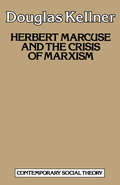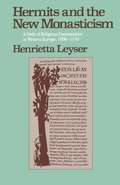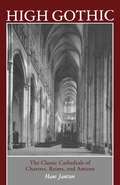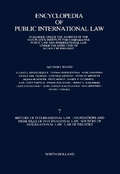- Table View
- List View
Hemostatic Mechanisms and Metastasis (Developments in Oncology #22)
by Kenneth V. Honn and Bonnie F. SloaneHepatic Encephalopathy in Chronic Liver Failure
by Livio Capocaccia, Joseph E. Fischer and Filippo Rossi-FanelliThe meeting which took place in Rome on November 19th and 20th of 1982 is easily the best meeting on hepatic coma that I have ever attended, and I have attended many. It was an exceedingly we- planned meeting with prolonged opportunity for discussion, and there was genuine interplay and exchange of ideas (not the usual picture of a rushed meeting with investigators presenting their own point of view and talking past each other without a meaningful ex change) which took place in Rome. My co-editors and I hope that the published transcript, which of course can only reflect what transpired in Rome on those two days, does justice to a very intellectually exciting and gratifying ex change of ideas. L. Capocaccia, J. E. Fischer and F. Rossi-Fanelli v CONTENTS Introduction 1 SECTION 1: PATHOGENETIC PROBLEMS IN HEPATIC ENCEPHALOPATHY Ammonia: The old and the new • • . • • • . • . • • • . • . • 5 L. Zieve Role of synergism in the pathogenesis of hepatic encephalopathy • • • • . • • . . . . • 15 L. Zieve y-Aminobutyric acid receptors in experimental hepatic encephalopathy •. •. • • 25 M. L. Zeneroli, ~. Baraldi,and E. Ventura A possible role for excitatory neurotoxic amino acids in the pathogenesis of hepatic en 41 cephalopathy • • • • • • • • • • • • • • • F. Moroni, G. Lombardi, G. Moneti, D. Pellegrini and C.
Hepatitis B: The Virus, the Disease, and the Vaccine
by Irving Millman Toby K. Eisenstein Baruch S. BlumbergToby K. Eisenstein Symposium Committee Chairperson Temple University School of Medicine Philadelphia, Pennsylvania 19140 This symposium is the thirteenth biennial clinical microbiology program sponsored by the Eastern Pennsylvania Branch of the American Society for Microbiology in cooperation with the Philadelphia area medical schools and the Bureau of Laboratories of the Pennsylvania Department of Health. This year a generous contribution from Merck, Sharp and Dohme has helped to make the program a reality. The subject matter for this symposium represents an attractive spectrum of medical, biological and molecular approaches to the practical solution of a public health prob1em--name1y, prevention of infection with the hepatitis B virus. The symposium may be unique in that it focuses on a product which was first marketed less than three months ago, but included in the program are presen tations on two new approaches to hepatitis B vaccine production which may replace the one which is newly unveiled. The rapidity of progress in our present era of biological research is indeed astonishing.
Hermits and the New Monasticism: A Study of Religious Communities in Western Europe 1000–1150
by Henrietta LeyserThe Herons Handbook (Helm Identification Guides)
by James Hancock James A. KushlanEverything you ever wanted to know about the world's herons.
Herstellung und Versteifungswirkung von geschlossenen Halbrundsicken (IFU - Berichte aus dem Institut für Umformtechnik der Universität Stuttgart #76)
by M. WidmannHerzinsuffizienz (Handbuch der inneren Medizin #9 / 4)
by G. RieckerBearbeitet von zahlreichen Fachwissenschaftlern
Heterotrophic Activity in the Sea (Nato Conference Series #15)
by Peter J. LeB Williams John E. HobbieIntroduction This book contains papers given at a NATO Advanced Research Institute (A.R.I.) held at Caiscais, Portugal, in November, 1981. The subject of the A.R.I. was marine heterotrophy; this is defined as the process by which the carbon autotrophically fixed into organic compounds by photosynthesis is transformed and respired. Obviously all animals and many microbes are heterotrophs but here we will deal only with the microbes. Also, we restricted the A.R.I. primarily to microbial heterotrophy in the water column even though we recognize that a great deal occurs in sediments. Most of the recent advances have, in fact, been made in the water column because it is easier to work in a fluid, apparently uniform medium. The reason for the A.R.I. was the rapid development of this subject over the past few years. Methods and arguments have flourished so it is now time for a review and for a sorting out. We wish to thank the NATO Marine Science Committee for sharing this view, F. Azam, A.-L. Meyer-Reil, L. Pomeroy, C. Lee, and B. Hargrave for organizational help, and H. Lang and S. Semino for valuable editing aid.
High Altitude and Man (Clinical Physiology)
by John B. West Sukhamay LahiriLeading authorities on high-altitude physiology contribute to this work, which is divided into three sections: Man at Extreme Altitude; Sleep and Restoration at High Altitude; and Physiology of Permanent Residents of High Altitude. Based on a symposium on physiology at high altitude sponsored by the American Physiological Society, the volume includes several chapters on the achievements of the 1981 American Medical Research Expedition to Mt. Everest, where the first physiological measurements at altitudes above 8,000 meters were recorded. With growing interest in the study of human performance in these conditions, this text marks a lasting achievement in high-altitude physiology.
High Gothic: The Classic Cathedrals of Chartres, Reims, Amiens
by Hans Jantzen James PalmesThis engaging study introduces the reader to one of the greatest achievements of Western art: the climactic phase of Gothic architecture in the first half of the thirteenth century. Through a comparative analysis of the cathedrals of Chartres, Reims, and Amiens, the author illuminates the technical, theological, artistic, and social factors that formed the High Gothic synthesis. Drawing on a lifetime of scholarship, he successively characterizes the different parts of the Gothic cathedral and describes the human context of the three great buildings.
Histocompatibility Testing 1984: Report on the Ninth International Histocompatibility Workshop and Conference Held in Munich, West Germany, May 6–11, 1984 and in Vienna, Austria, May 13–15, 1984
by E. D. Albert M. P. Baur W. R. MayrHistologie: Lehrbuch der Cytologie, Histologie und mikroskopischen Anatomie des Menschen
by L.C. Junqueira J. CarneiroHistologische Tumorklassifikation: Histopathologische Nomenklatur und Klassifikation der Tumoren und tumorartigen Veränderungen
by G. Breitenecker F. Asboth H. Budka H. Denk W. Feigl H. Hanak J. H. Holzner T. J. Kessler H. Köhler B. Lederer W. Leibl I. Obiditsch-Mayer S. WuketichDie Fortentwicklung der Medizin bringt auch in der Diagnostik der Tumoren und tumorartigen Veränderungen die immer raschere Vermehrung neu er kannter und zum Teil sehr unterschiedlich bezeichneter Entitäten mit sich. Das vorliegende Buch entstand aus dem vielerorts geäußerten Unbehagen der Kli niker und auch der Pathologen über die sogar international unterschiedlichen Nomenklaturen und die damit verbundenen Verständigungs- und Vergleichs schwierigkeiten hinsichtlich der Terminologie. Die vorliegende Klassifika tion erhebt keinen Anspruch auf Vollständigkeit, natürlich auch nicht auf langdauernde Gültigkeit, sondern ist als Nachschlagewerk und Entscheidungs hilfe für eine einheitliche und überregional verwendbare Kategorisierung und Benennung der häufig und der selten auftretenden Tumoren und tumorartigen Veränderungen gedacht. Bernd Lederer, dem damaligen Vorsitzenden der Österreichischen Gesell schaft für Pathologie, gebührt das Verdienst, die Idee zu einem solchen Buch zur Initiative gemacht zu haben und Arbeitsgruppen für die verschiedenen Be reiche zu installieren. Er hat den Abschluß der von ihm in Gang gebrachten Arbeit nicht erlebt. Die Arbeitsgruppen versuchten sich an bereits bestehende Klassifikationen (WHO, ICD-O-DA) zu halten und verwendeten auch anerkannte Monogra phien über einzelne Spezialkapitel. In manchen Fällen wurden Umstellungen vorgenommen oder eigene Vorschläge verwendet, wenn - meist nach unge zählten Sitzungen - Übereinstimmung erzielt werden konnte. In derartigen Fällen wurde die Auflistung der Entitäten durch Erläuterungen ergänzt. Im Glossar wird ein Teil der Kategorisierungsbegriffe definiert.
Historiography and Causation in Psychoanalysis
by Edwin R. Wallace, IVWhat do the psychoanalyst and the historian have in common? This important question has stimulated a lively debate within the psychoanalytic profession in recent years, bearing as it does on the very nature of the psychoanalytic enterprise. Edwin Wallace, a clinician with training in the history and philosophy of science, brings a ranging scholarly perspective to the debate, mediating between rival perspectives and clarifying the issues at stake in the process of offering his own thoughtful conception of the historical nature of psychoanalysis. For Wallace, the procedures, problems, and interpretive possibilities of psychoanalysis and history are strikingly constant and mutually illuminating. He insists, further, that the fundamentally historical nature of psychoanalysis poses no threat to its scientific dignity. In arriving at this verdict, Wallace pushes beyond his expansive treatment of the many parallels between history and psychoanalysis to a systematic consideration of the problem of causation in both disciplines. Tracing the historical background of causation in science, philosophy, history, and analysis, he offers a logical analysis of determinism and a critique of causal language in psychoanalysis while adumbrating the historical character of psychoanalytic explanation. Historiography and Causation in Psychoanalysis is a thought-provoking work that cuts across disciplinary boundaries. It will cultivate the historical sensibilities of all its clinical readers, broadening and deepening the intellectual perspective they bring to the dialogue about the nature of psychoanalytic work. Timely and rewarding reading for analysts, psychiatrists, and clinical psychologists, it will be welcomed by historians and philosophers as well.
Historiography and Causation in Psychoanalysis
by Edwin R. Wallace, IVWhat do the psychoanalyst and the historian have in common? This important question has stimulated a lively debate within the psychoanalytic profession in recent years, bearing as it does on the very nature of the psychoanalytic enterprise. Edwin Wallace, a clinician with training in the history and philosophy of science, brings a ranging scholarly perspective to the debate, mediating between rival perspectives and clarifying the issues at stake in the process of offering his own thoughtful conception of the historical nature of psychoanalysis. For Wallace, the procedures, problems, and interpretive possibilities of psychoanalysis and history are strikingly constant and mutually illuminating. He insists, further, that the fundamentally historical nature of psychoanalysis poses no threat to its scientific dignity. In arriving at this verdict, Wallace pushes beyond his expansive treatment of the many parallels between history and psychoanalysis to a systematic consideration of the problem of causation in both disciplines. Tracing the historical background of causation in science, philosophy, history, and analysis, he offers a logical analysis of determinism and a critique of causal language in psychoanalysis while adumbrating the historical character of psychoanalytic explanation. Historiography and Causation in Psychoanalysis is a thought-provoking work that cuts across disciplinary boundaries. It will cultivate the historical sensibilities of all its clinical readers, broadening and deepening the intellectual perspective they bring to the dialogue about the nature of psychoanalytic work. Timely and rewarding reading for analysts, psychiatrists, and clinical psychologists, it will be welcomed by historians and philosophers as well.
A History of Engineering in Classical and Medieval Times
by Donald HillIt is impossible to understand the cultures and achievements of the Greeks, Romans, Byzantines, and Arabs, without knowing something of their technology. Rome, for example, made advances in many areas which were subsequently lost and not regained for more than a millenium. This is a knowledgeable yet lucid account of the wonderful triumphs and the limitations of ancient and medieval engineering. This book systematically describes what is known about the evolution of irrigation works, dams, bridges, roads, building construction, water and wind power, automata, and clocks, with references to the social, geographical, and intellectual context.
A History of Engineering in Classical and Medieval Times
by Donald HillIt is impossible to understand the cultures and achievements of the Greeks, Romans, Byzantines, and Arabs, without knowing something of their technology. Rome, for example, made advances in many areas which were subsequently lost and not regained for more than a millenium. This is a knowledgeable yet lucid account of the wonderful triumphs and the limitations of ancient and medieval engineering. This book systematically describes what is known about the evolution of irrigation works, dams, bridges, roads, building construction, water and wind power, automata, and clocks, with references to the social, geographical, and intellectual context.
History of International Law · Foundations and Principles of International Law · Sources of International Law · Law of Treaties: Published under the Auspices of the Max Planck Institute for Comparative Public Law and International Law under the Direction of Rudolf Bernhardt
by Sam StuartHistory of International Law · Foundations and Principles of International Law · Sources of International Law · Law of Treaties
The History of Italy
by Francesco Guicciardini Sidney AlexanderIn 1537 Francesco Guicciardini, adviser and confidant to three popes, governor of several central Italian states, ambassador, administrator, military captain--and persona non grata with the ruling Medici after the siege of Florence--retired to his villa to write a history of his times. His Storia d'Italia became the classic history of Italy--both a brilliant portrayal of the Renaissance and a penetrating vision into the tragedy and comedy of human history in general. Sidney Alexander's readable translation and abridgment of Guicciardini's four-volume work earned the prestigious 1970 P.E.N. Club translation award. His perceptive introduction and notes add much to the understanding of Guicciardini's masterpiece.
The History of Italy
by Francesco GuicciardiniIn 1537 Francesco Guicciardini, adviser and confidant to three popes, governor of several central Italian states, ambassador, administrator, military captain--and persona non grata with the ruling Medici after the siege of Florence--retired to his villa to write a history of his times. His Storia d'Italia became the classic history of Italy--both a brilliant portrayal of the Renaissance and a penetrating vision into the tragedy and comedy of human history in general. Sidney Alexander's readable translation and abridgment of Guicciardini's four-volume work earned the prestigious 1970 P.E.N. Club translation award. His perceptive introduction and notes add much to the understanding of Guicciardini's masterpiece.
Hitler, Germans, and the Jewish Question
by Sarah Ann GordonThis book probes the background of the ultimately unexplainable evil of our century, the deliberate and unprovoked murder of millions of European Jews--and goes on to explore German reactions to that evil. Depicting the emergence in Weimar Germany of a new type of extreme anti-Semite, of which Hitler was the paramount example, Sarah Gordon discusses a number of related questions about the role of anti-Semitism in the rise of the Nazis and draws on hitherto unexamined Gestapo files, new data on court sentences, and a variety of other sources to describe the tiny numbers of courageous Germans who opposed Nazi anti-Semitism. She analyzes Hitler's own deranged world view, his use of his feelings about Jews as a political tool, and the extent of the German people's knowledge of his intentions and actions; she examines the history of German anti-Semitism from 1870 through the Nazi years; and she indicates several reasons for thinking that anti-Semitism, however virulent in certain individuals and groups, was not the major reason for Nazi electoral successes.No apologia for the German people, this work shows how a minority of extreme anti-Semites coexisted in Germany with the indifferent or fearfully disapproving majority, while the heroic few assumed the extreme risks of opposition. It offers a clear picture of the kinds of people who aided the Jews or publicly criticized their persecution, including surprising evidence of opposition in the Nazi party itself. In addition, it questions widely held beliefs that older Germans, males, Protestants, and the middle classes were disproportionately anti-Semitic; that bluecollar workers were basically immune to anti-Semitism; and that most Nazis were radical anti-Semites. It also discusses such subjects as the attitudes of German churches, the role of the military, and the socio-economic characteristics of Jews in Germany.






















